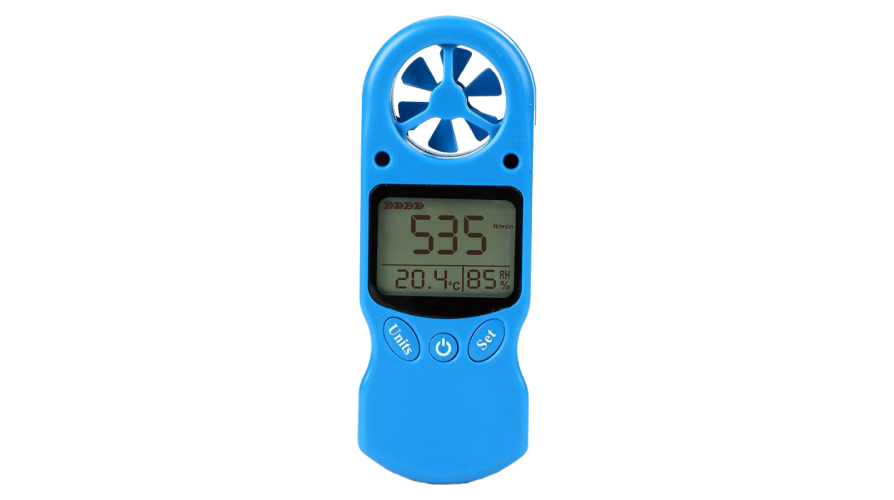Top Features to Search For in an Efficient Anemometer for Accurate Wind Dimension
Top Features to Search For in an Efficient Anemometer for Accurate Wind Dimension
Blog Article
All You Required to Understand About Anemometers: How They Work, Why They Issue, and Where to Make use of Them
Anemometers, though typically forgotten in the world of clinical tools, play a critical role in numerous fields, using valuable understandings right into wind speed and air flow patterns. As we dive into the ins and outs of anemometer modern technology, we will uncover the internal functions of these gadgets, their value, and the essential factors to consider when choosing the best anemometer for details applications.

Anemometer Fundamentals
A necessary tool made use of to determine wind rate and direction, the anemometer plays an important role in weather forecasting and various industries. An anemometer generally includes 3 or four cups that rotate in the wind, a vane that aims into the wind, and sensors to track the activities or rotations. By calculating the rotations or activities over a specific amount of time, the anemometer can establish wind rate. The vane helps establish wind direction by directing right into the wind, supplying important information for weather condition forecasting, aviation, maritime operations, ecological surveillance, and wind power applications.
There are various types of anemometers offered, consisting of mug anemometers, vane anemometers, hot-wire anemometers, and sonic anemometers, each with its distinct attributes and applications. Cup anemometers are frequently made use of for basic wind rate dimensions, while vane anemometers are favored for directional measurements. Hot-wire anemometers appropriate for low airspeeds, and sonic anemometers are ideal for high-precision dimensions in research study and industrial settings. Understanding the essentials of anemometers is essential for accurate wind information collection and evaluation across different fields.
Concepts of Anemometer Operation
Structure on the fundamental understanding of anemometer essentials, the concepts of anemometer procedure clarify the technicians behind wind speed and instructions dimensions. Anemometers operate on the concept of air movement influencing a sensing unit, causing it to turn. Mug anemometers, as an example, have 3 or even more cups that catch the wind, creating them to rotate faster as the wind rate rises. The rotation speed is after that exchanged a wind speed dimension. Vane anemometers, on the other hand, make use of a tail or a probe that straightens itself with the wind direction, offering a dimension of wind direction based on the alignment of the sensor. Hot-wire anemometers rely upon a warmed cord that cools down as wind overlooks it, with the rate of cooling establishing the wind rate. Ultrasonic anemometers procedure wind speed and instructions by assessing the moment it directory takes for ultrasonic signals to take a trip in between transducers. Comprehending these concepts is vital for reputable and exact wind measurements in various applications.
Relevance of Anemometers
The relevance of anemometers in meteorology and numerous markets can not be overemphasized. Anemometers play an important role in determining wind rate and direction, providing necessary information for weather forecasting, environment researches, environmental monitoring, and aeronautics operations. Meteorologists count on anemometers to collect precise wind information, helping them understand weather patterns, forecast tornados, and problem prompt warnings to the public. In markets such as building and construction, farming, renewable resource, and maritime procedures, anemometers are used to optimize processes, make sure safety and security, and raise performance. For instance, wind ranch drivers use anemometers to evaluate wind problems and make the most of power manufacturing from wind generators. In helpful resources the maritime field, anemometers aid ship navigation by giving real-time wind information to captains, helping them make informed decisions to make sure secure trips. On the whole, anemometers are important devices that add significantly to safety, efficiency, and informed decision-making in weather forecasting and a vast array of sectors.
Applications Throughout Different Industries
In the sustainable energy market, anemometers play an essential function in examining wind problems for wind ranch positionings, making sure ideal energy production. Industries like building and mining utilize anemometers to keep track of wind rates, important for safety visite site protocols, especially when working at elevations or in open-pit mines where solid winds can present dangers. In agriculture, anemometers assist farmers in handling plant spraying by offering real-time data on wind rate to avoid drift.

Picking the Right Anemometer for Your Needs
For general objectives, a mug anemometer is suitable for determining wind speed, while a vane anemometer provides wind direction data. Hot-wire anemometers are perfect for low airspeed measurements, and ultrasonic anemometers provide high precision and toughness.

Conclusion
Finally, anemometers play a vital role in determining wind speed and instructions throughout various industries. Understanding the principles of anemometer operation is crucial for choosing the appropriate gadget for certain needs. From meteorology to air travel, anemometers are vital devices for gathering precise data and guaranteeing security in various applications. It is very important to consider the significance of anemometers in order to make informed decisions when selecting one of the most appropriate tool for gauging wind conditions.
There are various types of anemometers readily available, consisting of cup anemometers, vane anemometers, hot-wire anemometers, and sonic anemometers, each with its special attributes and applications. Mug anemometers are commonly used for fundamental wind rate dimensions, while vane anemometers are favored for directional measurements. Hot-wire anemometers are suitable for low airspeeds, and sonic anemometers are optimal for high-precision dimensions in study and commercial setups.Structure on the foundational understanding of anemometer fundamentals, the principles of anemometer operation elucidate the auto mechanics behind wind rate and instructions measurements. For general functions, a cup anemometer is appropriate for gauging wind rate, while a vane anemometer provides wind direction information.
Report this page